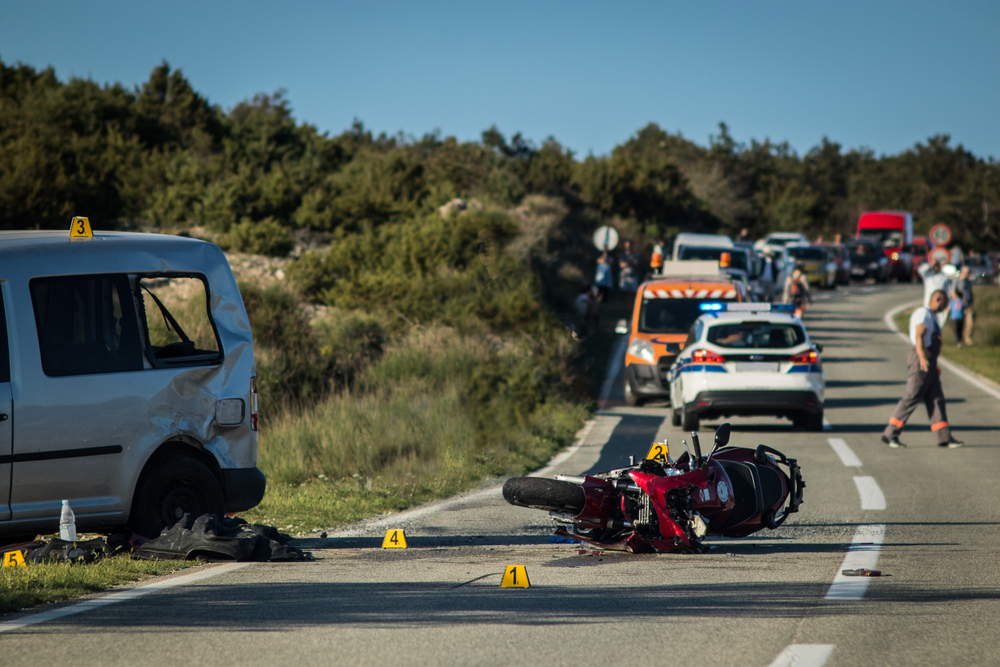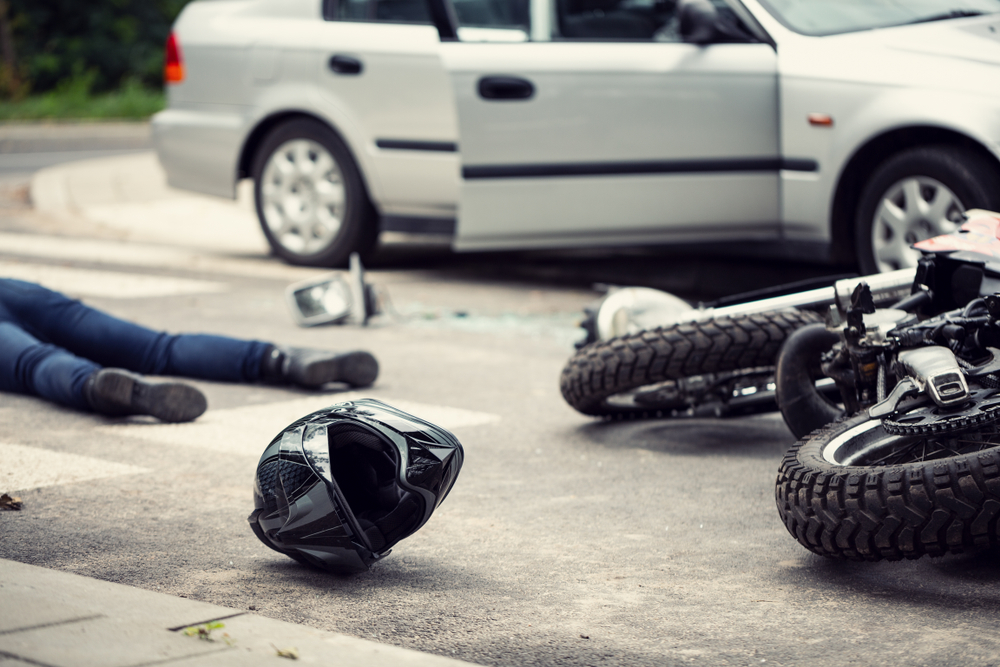According to recent studies from the NTSA (National Traffic Safety Administration), around six to seven percent of motorcyclists will be in an accident. That may not sound like a high number, but it’s far higher than it would be for other vehicles. Indeed, imagine if, every time you went outside, there was a 7% chance that you would be in an accident. Accordingly, you would operate your vehicle as safely as possible.

In the event that you were in a motorcycle accident that may have been caused by another party, it’s worth it to reach out to Belal Hamideh. An experienced motorcycle accident lawyer, he can let you know definitively whether or not you have a case. From there, he can help you to recover maximum compensation for everything you deserve.
You can schedule a case evaluation with him for free through this site or by calling.
Potential Role of a Skilled Motorcycle Accident Lawyer in Your Case
Whether you were at the helm or just a passenger, proficient motorcycle accident lawyer Belal Hamideh possesses the savvy and prowess necessary to champion your rights for obtaining all the compensation you merit, based on the adversities you’ve endured.
Motorcycling brings unmatched thrill, though it’s not devoid of dangers. Injuries from motorcycle accidents often exceed severity from other vehicular mishaps, inflicting severe trauma or even tragically claiming the life of you or your family members. Motorcycle accidents account for over 15% of all vehicular casualties in California.

The economic implications following a motorcycle accident are enormous, often rocketing into millions. Your medical expenditures could cover rehabilitation, long-term care, and income reduction. Other burdens include pain, distress, and more. Belal Hamideh is your support. Don’t hesitate to schedule a complimentary consultation with our team to explore potential avenues for attaining rightful compensation.
How Useful is Hiring a Motorcycle Accident Lawyer?
Undoubtedly. Engaging a seasoned California motorcycle accident lawyer is indispensable. A competent attorney will staunchly defend your interests and rights, endeavoring to win maximum compensation for your claim.
A lawyer enriched with a wealth of experience in dealing with motorcycle accident cases understands the subtleties of assessing your case to guarantee you capture all rightful compensation. They are proficient with all procedural deadlines, from lawsuit filing to evidence submission, and will always prioritize your best interests. They can bargain your medical dues to the minimal feasible amount, gather police/traffic reports, and manage countless other tasks allowing you to focus on recuperation.

Further, a versed motorcycle accident attorney is adept at traversing insurance claims. They comprehend the complexities of your coverages, their application to your claim, tactics used by insurance firms, and how to ensure you acquire every cent you’re deserving of from the insurance company, through either settlement or court. The right lawyer can bring immense benefits.
What Type of Payout Can I Expect for My Motorcycle Accident?
In California, you’re entitled to remuneration for both your monetary and non-monetary losses as part of your accident claim. Economic losses encompass costs associated with your injury, such as medical bills, income loss, motorcycle repair or replacement. In graver cases, these damages may extend to rehabilitation services, future medical care, housing alterations, among others.

Non-economic damages compensate for the emotional and psychological toll of your accident – endured pain, emotional turmoil, and fundamental life alterations you’ve had to face. This may cover “Loss of Consortium”, factoring in the loss of a spouse, or “Loss of enjoyment of life”, for the inability to engage in activities enjoyed prior to the accident. Our firm is committed to ensuring you capture the compensation you rightfully deserve.
Who Could Be The Legal Target of My Motorcycle Accident Lawsuit?
The party at fault for your motorcycle accident may be legally pursued. Beginning a lawsuit is just the first step, though. You’ll need to establish that the other driver’s carelessness caused the accident and your subsequent harm.
Your attorney will assist you in gathering evidence for four key elements of a negligence case. First, you must establish that the defendant had a “duty of care” to you and other road users to drive safely. Second, you must prove that this duty was violated. Third, you must draw a clear line between this violation and your accident. Lastly, you need to verify that your injuries are a direct result of the accident. An experienced lawyer can effectively build this case.
How Long Should I Expect My Motorcycle Accident Claim to Take?
Each accident is unique and, as a result, settlement times vary. A number of our clients have received settlements within weeks, but some cases have taken longer, going to trial. Our dedicated team fights relentlessly for the rights of accident victims like you. The sooner you engage a lawyer, the faster we can begin working on your case.
Common Motorcycle Accident Scenarios
Motorcycle crashes often involve larger vehicles, which is a common occurrence in California due to the heavy traffic. The Port of California, one of the busiest cargo ports globally, sees large vehicles like semi-trucks on its roads daily. Coupled with the nearly 900,000 vehicles owned by residents, risks for motorcyclists increase significantly.
Sadly, driving while intoxicated is the leading cause of motorcycle incidents, accounting for around 25% of fatal crashes. Other frequent culprits include speeding, inexperienced bikers/drivers, reckless/distracted driving, and lane splitting. However, a range of external factors can contribute to accidents, such as defective bikes, unsafe road conditions, reduced visibility, and more.
Should you suffer a motorcycle accident, you could sustain injuries ranging from fractures and whiplash to severe road rash, traumatic brain injuries, spine injuries, or even different levels of paralysis. No matter the severity of your injury, our team stands ready to support you.
What to Do Following a Motorcycle Accident
After an accident, you might feel a rush of adrenaline, shock, and disorientation. Here’s a step-by-step guide on what to do:
Prioritize your safety. Try to remove yourself from danger and seek medical help immediately, whether or not you think you’ve been hurt.
Notify the police. Filing a police report is essential for your personal injury claim.
Gather contact information. Collect names, contact details, licenses, addresses, insurance info, and vehicle descriptions from all involved parties.
Document the accident. If possible, take photographs of your injuries and the crash site.
Don’t admit fault. You’re under no obligation to accept blame at the crash scene.
Seek legal advice. Our experienced attorneys are here to guide you through each step of the legal process.
What Happens if I Don’t Wear My Helmet?
Motorcycle helmets are crucial for your safety and are mandated by law in California. This legislation enforces the use of helmets for all motorcyclists and their passengers. If you are involved in an accident without a helmet, you may be deemed partially responsible for your injuries.
However, California operates as a “comparative negligence state,” meaning that even if you weren’t donning a helmet during the accident, you can still pursue and receive financial remuneration for your pain, suffering, and injuries. We have a proven history of assisting clients in such scenarios.
What If I Don’t Have Insurance?
Being uninsured doesn’t mean that you can’t claim compensation for your injuries as long as the accident wasn’t your fault. Yet, lack of liability coverage might significantly reduce your compensation. If you are part of a motorcycle accident while uninsured, you will face penalties for no insurance, as California law requires all drivers to have liability insurance.
Primarily, your penalty results in a limitation on seeking compensation for non-economic damages like pain and suffering. Your compensation claim would focus on economic damages. However, we are well-equipped to help you garner the maximum possible amount.
Why Should You Consult a Trusted California Motorcycle Accident Lawyer?
Accident attorney Belal Hamideh has a long-standing record of aiding victims of motorcycle accidents. He is prepared to harness his knowledge and skillset to ensure your case is victorious. Our payment method ensures you pay only after we win your case.
It’s understandable to feel ambivalent about liaising with a lawyer after your accident. Yet, the earlier you do, the better your likelihood of securing the highest compensation. You have a two-year timeframe from the accident to file a lawsuit for your injuries. Starting earlier means receiving your compensation sooner. We’re always ready to aid you, so don’t delay.
California Motorcycle Laws
These laws may pertain to your situation. If you have further questions, don’t hesitate to reach out to Belal.
2009 California Vehicle Code – Section 27800-27803 :: Article 7. Motorcycles
VEHICLE CODE
SECTION 27800-27803
- It is unlawful for a driver of a motorcycle or a motorized
bicycle to carry any other person thereon, except on a seat securely
fastened to the machine at the rear of the driver and provided with
footrests, or in a sidecar attached to a motorcycle and designed for
the purpose of carrying a passenger. Every passenger on a motorcycle
or a motorized bicycle shall keep his feet on the footrests while
such vehicle is in motion.
- A person shall not drive a two-wheel motorcycle that is
equipped with either of the following:
(a) A seat so positioned that the driver, when sitting astride the
seat, cannot reach the ground with his or her feet.
(b) Handlebars so positioned that the hands of the driver, when
upon the grips, are more than six inches above his or her shoulder
height when sitting astride the seat.
- (a) The department may adopt reasonable regulations
establishing specifications and standards for safety helmets offered
for sale, or sold, for use by drivers and passengers of motorcycles
and motorized bicycles as it determines are necessary for the safety
of those drivers and passengers. The regulations shall include, but
are not limited to, the requirements imposed by Federal Motor Vehicle
Safety Standard No. 218 (49 C.F.R. Sec. 571.218) and may include
compliance with that federal standard by incorporation of its
requirements by reference. Each helmet sold or offered for sale for
use by drivers and passengers of motorcycles and motorized bicycles
shall be conspicuously labeled in accordance with the federal
standard which shall constitute the manufacturer’s certification that
the helmet conforms to the applicable federal motor vehicle safety
standards.
(b) No person shall sell, or offer for sale, for use by a driver
or passenger of a motorcycle or motorized bicycle any safety helmet
which is not of a type meeting requirements established by the
department.
- (a) A driver and any passenger shall wear a safety helmet
meeting requirements established pursuant to Section 27802 when
riding on a motorcycle, motor-driven cycle, or motorized bicycle.
(b) It is unlawful to operate a motorcycle, motor-driven cycle, or
motorized bicycle if the driver or any passenger is not wearing a
safety helmet as required by subdivision (a).
(c) It is unlawful to ride as a passenger on a motorcycle,
motor-driven cycles, or motorized bicycle if the driver or any
passenger is not wearing a safety helmet as required by subdivision
(a).
(d) This section applies to persons who are riding on motorcycles,
motor-driven cycles, or motorized bicycles operated on the highways.
(e) For the purposes of this section, “wear a safety helmet” or
“wearing a safety helmet” means having a safety helmet meeting the
requirements of Section 27802 on the person’s head that is fastened
with the helmet straps and that is of a size that fits the wearing
person’s head securely without excessive lateral or vertical
movement.
(f) This section does not apply to a person operating, or riding
as a passenger in, a fully enclosed three-wheeled motor vehicle that
is not less than seven feet in length and not less than four feet in
width, and has an unladen weight of 900 pounds or more, if the
vehicle meets or exceeds all of the requirements of this code, the
Federal Motor Vehicle Safety Standards, and the rules and regulations
adopted by the United States Department of Transportation and the
National Highway Traffic Safety Administration.
(g) In enacting this section, it is the intent of the Legislature
to ensure that all persons are provided with an additional safety
benefit while operating or riding a motorcycle, motor-driven cycle,
or motorized bicycle.
2023 California Code
Vehicle Code – VEH
DIVISION 12 – EQUIPMENT OF VEHICLES
CHAPTER 5 – Other Equipment
ARTICLE 7 – Motorcycles
Section 27803.
- (a) A driver and any passenger shall wear a safety helmet meeting requirements established pursuant to Section 27802 when riding on a motorcycle, motor-driven cycle, or motorized bicycle.
(b) It is unlawful to operate a motorcycle, motor-driven cycle, or motorized bicycle if the driver or any passenger is not wearing a safety helmet as required by subdivision (a).
(c) It is unlawful to ride as a passenger on a motorcycle, motor-driven cycles, or motorized bicycle if the driver or any passenger is not wearing a safety helmet as required by subdivision (a).
(d) This section applies to persons who are riding on motorcycles, motor-driven cycles, or motorized bicycles operated on the highways.
(e) For the purposes of this section, “wear a safety helmet” or “wearing a safety helmet” means having a safety helmet meeting the requirements of Section 27802 on the person’s head that is fastened with the helmet straps and that is of a size that fits the wearing person’s head securely without excessive lateral or vertical movement.
(f) This section does not apply to a person operating, or riding as a passenger in, a fully enclosed three-wheeled motor vehicle that is not less than seven feet in length and not less than four feet in width, and has an unladen weight of 900 pounds or more, if the vehicle meets or exceeds all of the requirements of this code, the Federal Motor Vehicle Safety Standards, and the rules and regulations adopted by the United States Department of Transportation and the National Highway Traffic Safety Administration.
(g) In enacting this section, it is the intent of the Legislature to ensure that all persons are provided with an additional safety benefit while operating or riding a motorcycle, motor-driven cycle, or motorized bicycle.
(Amended by Stats. 1997, Ch. 710, Sec. 4. Effective January 1, 1998.)
